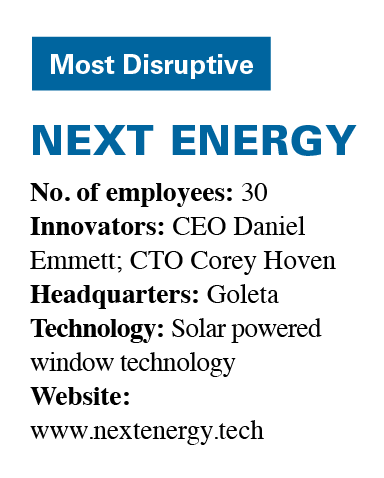For tech startup Next Energy, opportunity didn’t knock on the door
By Marissa Nall | Staff Writer
While half of the cleanroom at Next Energy Technologies is dedicated to building and scaling up its solar windows, the other half sits empty, waiting for the installation of a custom pilot manufacturing line that will transition the technology to the factory floor.

“We’re trying to disrupt the window supply chain and manufacturing process as little as possible with a highly disruptive product,” said co-founder and CEO Daniel Emmet. “We think we can really change the world with this technology, change the way buildings are built and how you think of a facade, going from being a passive element to being a very active, functional part of the building’s performance.”
Thanks to a relationship with its first licensee, a U.S. glass manufacturer that led the 2017 capital raise, Next has worked closely with two leading glass equipment makers which will ultimately private label the system to mutual customers, Emmett said.
“We don’t want to be in the business of manufacturing equipment and production lines,” he said. “Our focuses then can really stay around the research and development of the materials themselves and the performance, because there’s potentially an infinite number of different permutations we can do with different colors, different visible light transmissions and different materials that we can integrate onto.”
As soon as the R&D team finds a new formula for the thin-film, soluble small molecule technology, they immediately work to transition it to the slot-die coating process that is standard for the window industry, Emmet said.
The process has scaled up to 14 inches by 20, a size used for most official window certifications, and the new pilot line will grow that to more than one square meter.

Cecilia Lee shows off a window with Next Energy’s solar-powered technology.
“All the focus is on automating and using commercial, industrial tools to do the steps as we scale it,” he said, demonstrating how the process coats the glass in layers of the material, then scribes it into a more efficient pattern of cells before laminating and sealing it much like a typical window. “All that is taken into account in terms of what they’re doing currently and how we would need to modify and supplement the steps for that process.”
Other machinery puts finished windows through their paces, cycling them through hot and cold temperatures, humidity, and flash testing to gauge how efficiently they convert light into energy. While dust buildup is one of the leading causes of decreased performance in traditional solar panels, window washing is typically built into the cost of most commercial buildings, Emmett said, decreasing the overall cost of going solar.
With about a year and a half left on a grant from the U.S. Department of Energy, the company was also selected to participate in Wells Fargo’s Innovation Incubator Program, or IN2, in October. In addition to $250,000 in funding for testing and validation, the program will also connect Next to Wells Fargo’s network of experts and Golden, Colo. research facility.
“We’ve been pretty low-profile since we’re still not in the market, but we’re getting a fair amount of inbound interest from architects and building engineers and designers,” Emmett said. “So our motivation is getting our first product out there as quickly as possible.”
But the first product sales could still be another two years away, he said.
“It’s a long-term commitment. Taking something right out of the labs in the university in its infancy to where we are today is huge progress, but it definitely takes time.”



